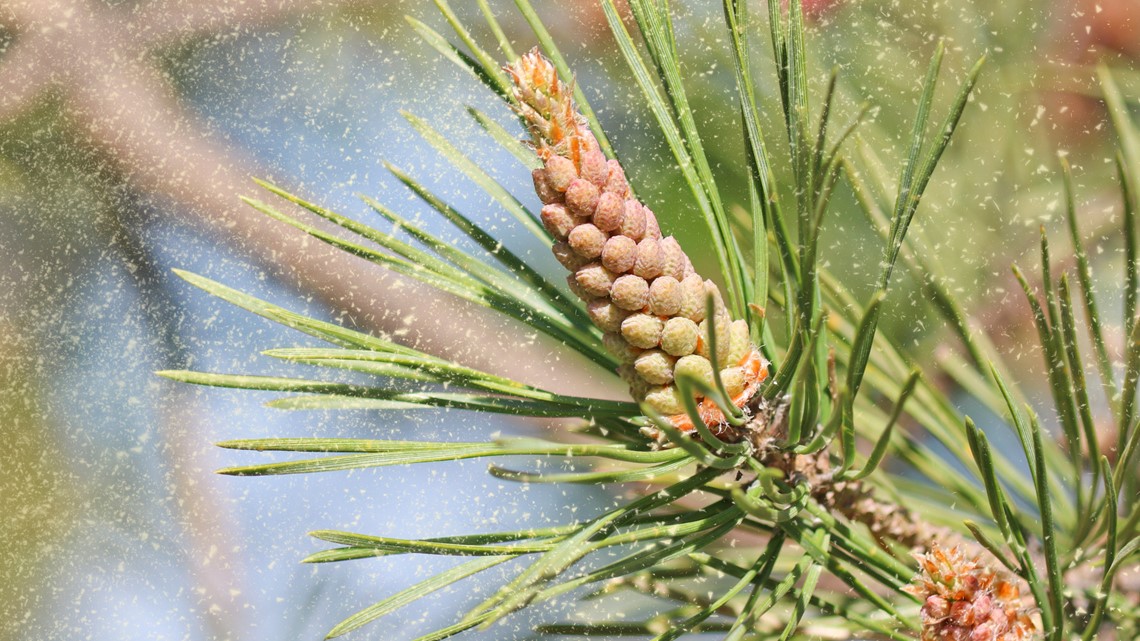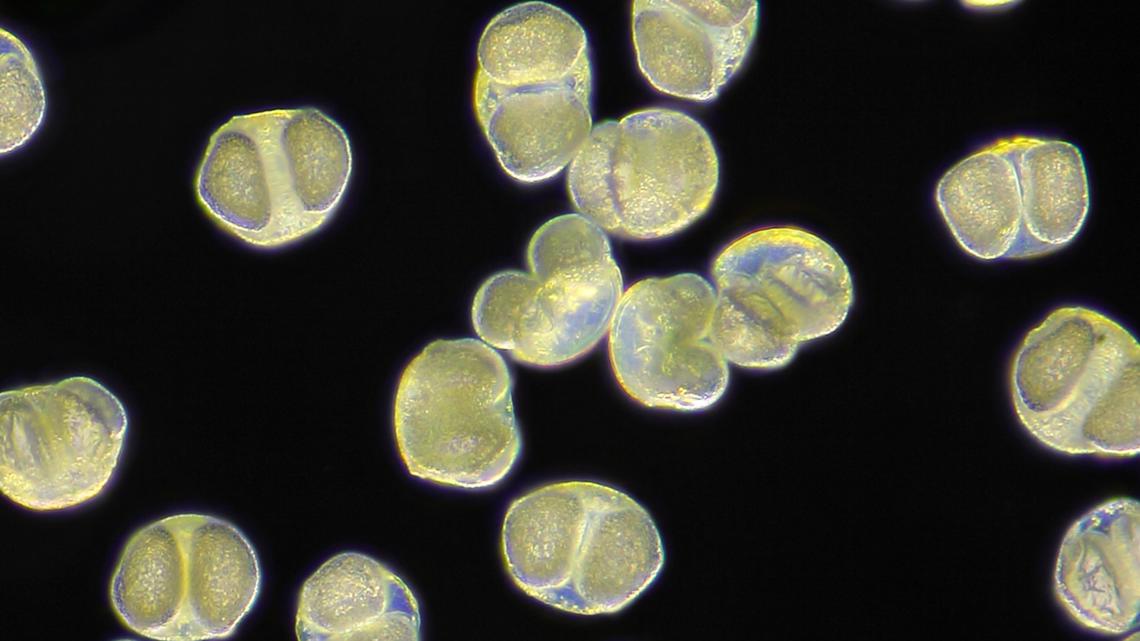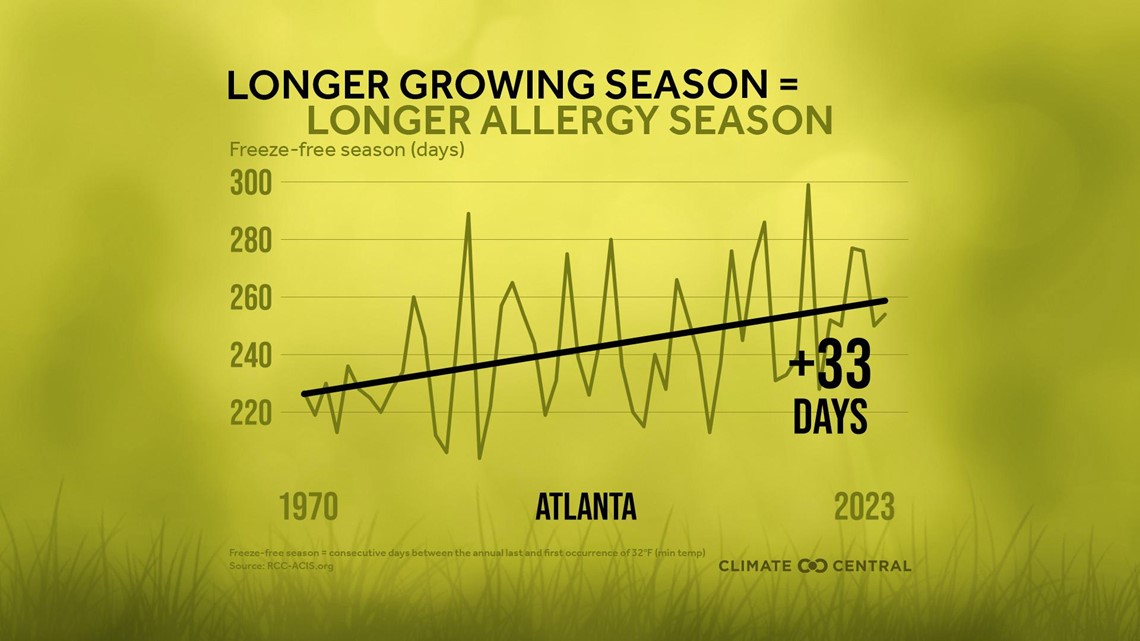ATLANTA — If you're an allergy sufferer, you know that the pollen count is high.
But just how high? How do they come up with the numbers?
For that, we traveled to Atlanta Allergy and Asthma, the site of Atlanta's pollen counts since its conception in the early 1980s.
Kim Norwood wakes up and arrives at work each day while many of us are still asleep. As a pollen count technician, her work is seen by hundreds of thousands of people in metro Atlanta every day.
Of course, pine pollen coats cars and the ground outside this time of year. But as Norwood describes, it's the pollen you can't see that often triggers bigger allergic reactions.
"The yellowness that you see on your cars each and every day is not really an allergen, so it doesn't really affect you. It's like a mind game. You would think that it triggers the allergies, but it really doesn't do anything for the individual at all. It's what you don't see that actually affects you," Norwood said.
Different types of allergens impact those who suffer from allergies: tree pollen, mold spores, dust in your house, yellow jackets, and even cockroaches. Yes, cockroaches.
But let's get away from those creepy crawly invertebrates and back to the trees.


Tree pollination 101
Lots and lots of trees are blooming outside. Pollination is just the act of transferring pollen grains from the male anther of a flower to the female stigma. Put plainly, it's tree sex.
Because trees are rooted in the ground, they cannot just uproot themselves and go at it, so to speak.
So they need a little help. That's where wind and animals (the birds and the bees) step in to get pollen to move from one flower to another.
As pollination happens outside, tiny pollen grains are easily picked up by the wind and transported to help the process proceed.
The process of counting pollen
How do they know which type of pollen is out there?
The counting of pollen starts with a Rotorod machine. Every day, a small greased I-Rod is put on this machine, which sits outside one of Atlanta Allergy And Asthma's clinics. About once every 10 minutes, it rotates rapidly for 30 seconds, collecting pollen grains and mold/fungal spores along the way.
Every 24 hours, the rod is brought in and a new rod is put outside.
Then, they can start the pollen counting science.
The lab looks like a mini chemistry classroom. We focus near the microscope for the pollen counting process. Around the corner, an entire wall of refrigerators filled with immunotherapy allergens and mixed immunotherapy solution vials sits, ready to help patients combat seasonal allergies.
Once Norwood brings the I-Rods inside, she marks the ends of the rods with a Sharpie. Then, carefully, she applies a stain to make the pollen grains and mold spores more visible as she places the rods on a slide to be examined under the microscope.
Now comes the fun but very tedious process. They slowly work through the rods and look to identify and count all of the various pollen grains and mold spores on the rod.
It's not always a quick task. They can find hundreds of different variations of pollen grains. Some are fairly circular, others have more jagged edges, and then there's one shape of tree pollen that is distinctly different from the rest.
"This is the pine tree pollen grains under the microscope. It's very distinctive in character. And it actually shows its color when it's produced outside each and every day," Norwood said.
Norwood showed us a slide of grains that overlapped three oblong ovals.
They look reminiscent of Mickey Mouse. So perhaps they're the most magical type of pollen grain to count.


The process of counting pollen does not come naturally and quickly. The laborious process is learned through a training program that each of the pollen count technicians attends when they begin their work at the clinic. But much of what they learn comes through experience.
After the technicians count the pollen grains on the small sample size under the microscope, they need to convert it to the daily count we use daily. A computer program helps to convert it into grains of pollen per meters cubed, which is the number you see on TV and online.
The history of counting pollen
Atlanta Allergy and Asthma has always done the pollen count for the City of Atlanta.
It began in the early 1980s. But at that time, it wasn't broadcasted on every news outlet and multiple internet sites each day. It was just used internally at the office so that doctors had a better idea of the main culprits that were affecting their patients on a daily basis.
But its popularity grew. In the 1990s, they established a phone line. People could call in to hear the pollen count.
Now fast-forward to the present day. That pollen count is now put online and broadcast on TV stations every day.
Atlanta's record pollen count and growth
Pollen season has its extremes. Sometimes, the daily pollen count reaches above 3,000 to 4,000 grains per cubic meters. Our record highest pollen count was 9,369 grains per cubic meter back on March 20, 2012.
Dr. Christopher Chu, an Allergist with Atlanta Allergy & Asthma, said pollen season itself is growing.
"It's been starting earlier and lasting longer. So unfortunately, those patients with seasonal symptoms, they will have a little bit more suffering," Dr. Chu said.
In 2021, Atlanta Allergy & Asthma contributed to an allergy study published in the Annals of Allergy, Asthma & Immunology. It examined pollen data from 1992 to 2018. The findings showed that pollen season wasn't just growing in length but also in intensity. Although variations did occur yearly based on weather trends, they found a distinct shift earlier in the start of pollen season. In addition, the concentration of oak pollen and juniper pollen increased in the 27-year period.
Climate Central's analysis released in 2024 also showed similar trends. Atlanta's growing season has shifted earlier and is now 33 days longer than it was in 1970. A longer growing season translates to a longer pollen season and an allergy season.
RELATED: Can I plant now? | What to know about Georgia's growing season and gardening during cooler weather



